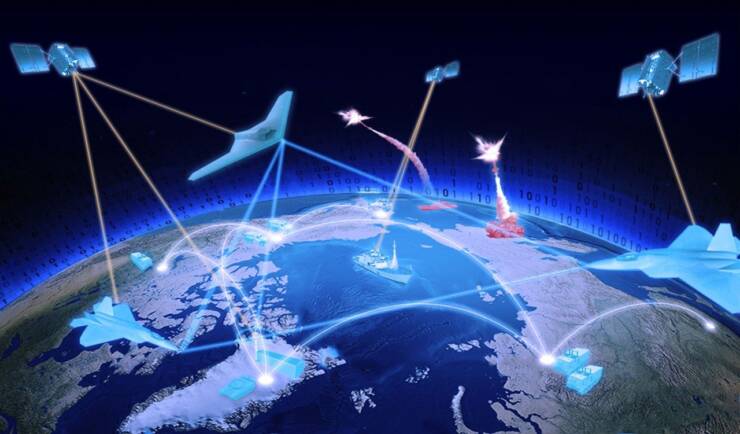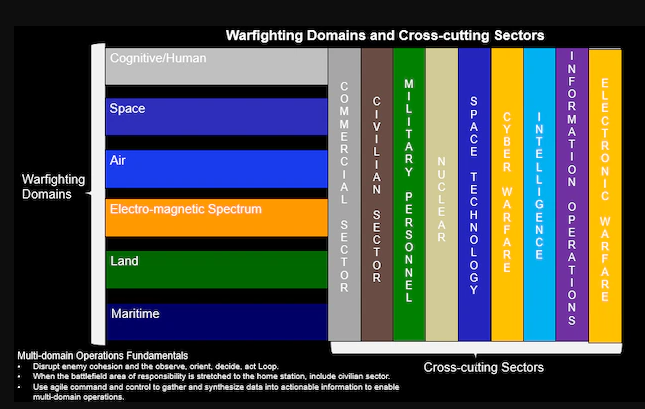
The paradox of warfare seems to be juxtaposed between the use of physical force vis-a-vis an orchestrated virtual combat executed by a string of robots in many shapes and forms whose DNA is Artificial Intelligence (AI) riding on Machine Languages (ML) and stretching boundaries beyond the realms of conventional battle spaces.
Strange as it may sound, it is an accepted axiom that warfare today defies convention whose manifestation remains a continuous process with a very thin and porous demarcation of peace and war as we understand.
While the essence of warfare has been political in nature, the execution has seen a myriad change based on national aspirations, global compulsions political ideologies and above all, technological transformation. Thus, the art of warfare itself has been evolutionary in nature where competing adversaries have always tried to out manoeuvre the opponent by a combination of conceptual evolution complimented by a matching destructive capability on land, sea and air.
Over the years, the concept of operations and the lethality of combat have manifested itself from a rudimentary linear standalone battle to the traditional trench warfare that lacked combat mobility, followed by manoeuvre warfare where speed was the essence and destruction intrinsic to it.
Over time this concept graduated to an integrated air-land battle in its true sense of its terrestrial application with the maritime intervention as a part of the whole-of-nation approach resulting in proliferation of destructive weapon systems albeit raising the threshold to nuclear weapons.
This catastrophic destructive capability reigned in conventional combat but stoked the concept of military deterrence. Notwithstanding that, it also precipitated irregular warfare by non-state actors, as a low cost non discernible option, to further political tenants.
Along with it came hybrid warfare whose positional value along the continuum of conflict was a combination of conventional warfare in a limited sense, irregular warfare and a new dimension of information warfare. It is brutal violence perpetrated by non-state actors to gain ideological legitimacy and influence over the relevant populations.
Simultaneously the world is witness to the dramatic influence of information technology and the power of the Internet making national boundaries irrelevant while exponentially increasing the pace of everyday life.
Its impact on war fighting was axiomatic with the propensity to inflict incalculable damage with the least effort. This was the genesis of cyber warfare where access to actionable information and measured denial of the same to the adversary became the new vertical on the continuum of conflict resulting in doctrinal changes world over. It necessitated space-based satellite communication for seamless information flow besides being an interdiction arena for long range missiles as part of a nation’s missile defence system thereby significantly enhancing the importance of the space domain.

Thus militarisation of these newer domains of function has given rise to the new concept of Multi Domain Operations (MDO). It is a continuation of the erstwhile principles of air-land battle but extending to the cyber and space domains. Broadly this concept succeeds the well-known “combined and joint operations” to encompass new domains like space, cyber and technological strides in artificial intelligence and more recently social media with one clear aim of achieving combat superiority over matching adversaries .
The conceptual framework on MDO has evolved rapidly in recent years with even the terminology becoming ever more ambitious, from Multi-Domain Battle to Multi-Domain Operations to All-Domain Operations.
Background
The conceptual evolution of MDO and its subsequent development began a decade ago when military strategists asked the prophetic question: “What after ‘joint’?” This incisive inquiry was spurred by the fact that historical approaches to achieving superiority in the air, land, and sea domains may no longer be valid.
The principal factor driving this phenomenon was a global proliferation of advanced information technology. It was also the consequence of the new National Security Strategy (NSS) and National Defence Strategy (NDS), issued by the US in 2018 against Russia and China, the two peer competitors, who were known to develop strategies to defeat US power by developing new weapons, tactics and anti-access and area-denial (A2/AD) systems. They were investing heavily in the space and cyber domains. Hence in order to maintain supremacy over these competitors, the need to conduct operations in all domains—land, sea, air, space and cyber became an operational imperative.
It legislated the initial objective for the Joint Force in such a conflict to penetrate and disintegrate an adversary’s layered and networked arrays of anti-access and area-denial (A2/AD) systems by conducting rapid and coordinated attacks across all domains. So the central idea of the MDO concept is to disintegrate enemy A2/AD systems and exploit the resultant freedom of manoeuvre to achieve strategic objectives.
Concept of Multi-Domain Operations
Multi-Domain Operations (MDO) is a concept that can achieve competitive advantage over a near-peer adversary by presenting multiple complementary threats where each requires a response, thereby exposing the adversary’s vulnerabilities to other threats.
It is the artful combination of these multiple dilemmas, rather than a clear overmatch in terms of any particular capability, that produces the desired advantage. In other words, MDO is a way to provide effects with timing and tempo that the enemy cannot compete with.
The moot question is how is MDO any different than fighting together as a Joint Force? In the past, operations were single-domain focused, with coordinated effects at the apex level to achieve the desired results. These operations today are layered or synchronized but not fully integrated. The authorities for space/cyber forces are retained largely at the strategic or national level while authorities for air and land operations remain at the operational level. Situational awareness capabilities are not designed to provide an integrated understanding of the battle space that spans all domains, and C2 constructs do not provide the necessary agility to synchronize effects.
MDO, on the other hand, warrants a combined domain superiority approach to make decisions at a pace and scale needed to effectively out manoeuvre any peer adversary across all levels in a synthesised manner. This legislates an operational process that creates a common operating picture across domains that will connect the right sensor to the right processor, and ultimately to the right shooter besides gaining operational ascendency over the adversary in time and space.
MDO postulates the need for right operational systems and people with appropriate skill sets. The US Army has created its first unit to combine long-range targeting, hacking, jamming, cyber surveillance and space monitoring as a transformation process to put MDO in place. The unit is called I2CEWS, which stands for all the capabilities it brings: Intelligence, Information, cyber, electronic warfare, and space. This unit was raised at JB Lewis-McChord, Washington, to counter the Chinese threat.
Domain Analysis
The traditional domains are air, sea, land, space, and cyberspace. A definition of domain is a critical macro manoeuvre space whose access or control is vital to the freedom of action and superiority required by the mission. It is simply an area that one must have access into and an area in which one can make effects and this arena does not have to be physical.
Hence disruptive and destructive cyberattacks are becoming a part of conflict between states, within states, and among non-state actors resulting in nations according top priority. Close on the heels is the recognition of space as a new operational domain, alongside air, land, sea and cyberspace.

This consideration of space as a war-fighting domain stems from the fact that of late, space is being increasingly used for military purposes by way of communication, navigation systems and paths for missile trajectories of long range missiles.
The bulk of digital connectivity rides on space-based satellites. Thus it goes without saying that in times of conflict neutralising space assets has to form part of any war fighting strategy. If that be so then in recent times, a sixth domain has been actively under consideration lately due to the rise in information operations, namely cognitive domain.
The cognitive domain is becoming increasingly important alongside space and cyber technologies. The domain has opened up an information overload whose information sharing speed overtakes actual battle field tempo and combat speed. In doing so, the power of the social media to propagate misinformation for public consumption can rapidly subvert opinions and global reactions, making the traditional gatekeepers ineffective and easier for any actor, state or non-state, to exploit it to their advantage. Twitter, Facebook, and other social media platforms have collectively formed the cognitive domain.
Cross Play of War-fighting Domains and Physical Sectors
From an operational framework, all the segments of the battle space can be exploited or are equally vulnerable at any given time. To elucidate, the tactical battle area broadly can be segmented into three distinct space—deep battle space, contact battle space, and the combat rear area.
In addition, from a strategic standpoint, areas extending into the adversaries’ strategic rear are critical to the outcome of the battle. Similarly safeguarding own strategic rear assumes significance. Therefore what the concept attempts to achieve is to create battle space dominance while neutralising the vulnerabilities created through new technologies across domains in each of these spaces which can be effectively crafted to subvert the adversary and cripple his war efforts. Therefore, the fundamentals of MDO are to disrupt enemy’s cohesion and the OODA (Observe, Orient, Decide, Act) loop while using agile command and control to gather and synthesize data into actionable information. Thus military operations in all six war fighting domains have to remain mutually exclusive, collectively inclusive and synchronised as an intra as well as inter domain function at the operational and strategic levels.

In the figure above, the domains are the horizontal bars, to include the cognitive domain, while the cyber domain is represented as the larger electromagnetic spectrum. The interactive sectors are a combination of military, government, and commercial entities at the local, state, and national level. These sectors exceed the traditional confines of purely military endeavours or domains. These cross-sectors include the commercial sector, civilian sector, military personnel, space technologies, cyber, nuclear, intelligence, information operations, and electronic warfare. Where each of the domains intersects with a cross-cutting sector is considered as an action point.
A commander or planner should look at this framework with an offensive posture in mind and decide on the desired effects at various action points. In this manner, one could throw multiple dilemmas at the enemy in various domains, thereby slowing their decision-making process and consider all the potential targets through various means of attack. Likewise, one could put a defensive hat on and consider how we may be vulnerable at each action point. This framework can be utilized at the tactical level as mentioned above, and can also be effectively utilized at the operational and strategic level to address objectives in all domains and across all cross-cutting sectors at the national level.
MDO in the Indian Context
In the Indian context, China remains the principle adversary. The recent stand-off further reinforces this fact. China, on its part, has been developing a range of multi-domain capabilities against the US, being its main adversary, in collusion with Russia. Therefore in a conflict situation with India, it can be deployed against India as well. Pakistan, on the other hand, has been perpetrating hybrid war under the backdrop of a nuclear equilibrium backed by conventional force in a collusive partnership with China. This collusive interplay has shrunk the conventional space while increasing the implied threat in other domains.
Although the physical manifestation of conflict seems remote but the propensity of multi-domain supremacy is relatively high. Therefore, developing a credible MDO capability will now have to be the new normal for deterrence—a passive active deterrence—that has the potential to be scaled up. MDO is here to stay, it is only a question of how soon.
Conclusion
The concept of MDO or All Domain Operations is still maturing in militaries that have initiated the process. Some milestones have been achieved, like the establishment of Space Command and Cyber Command in recognized warfighting domains or the implementation of new technologies like AI or ML as operational capabilities. The use of AI and ML is transforming the way we process situational awareness.
However, multiple challenges remain. The other domains, like EMS or the cognitive domain, have to legislate clear boundaries and the requirement to understand the scope of the network to be built across domains. The overarching command and communication structure must also focus efforts on critical challenges to deliver requirements that are tactical, technical, and conceptual resources that are required to enable the decision-making process and to determine the appropriate roles within human and AI decision-making processes. This will allow for better tactical and operational linkages across the sectors andwill aid in a rapid, dynamic response in the TBA as well as the larger strategic envelope.
References
Curt Taylor and Larry Kay, “Putting the Enemy between a Rock and a Hard Place: Multi-Domain Operations in Practice,” Modern War Institute, 27 August 2019, https://mwi.usma.edu/.
Gen David L. Goldfein, “2019 Air, Space, and Cyber Conference—General David Goldfein,” streamed live on 17 September 2019, YouTube video, 1:15:47, https://www.youtube.com/.
–The writer is a former GOC-Indian Army and presently a Strategic Consultant & Principal Advisor. Views expressed are personal and do not necessarily reflect the views of Raksha Anirveda








